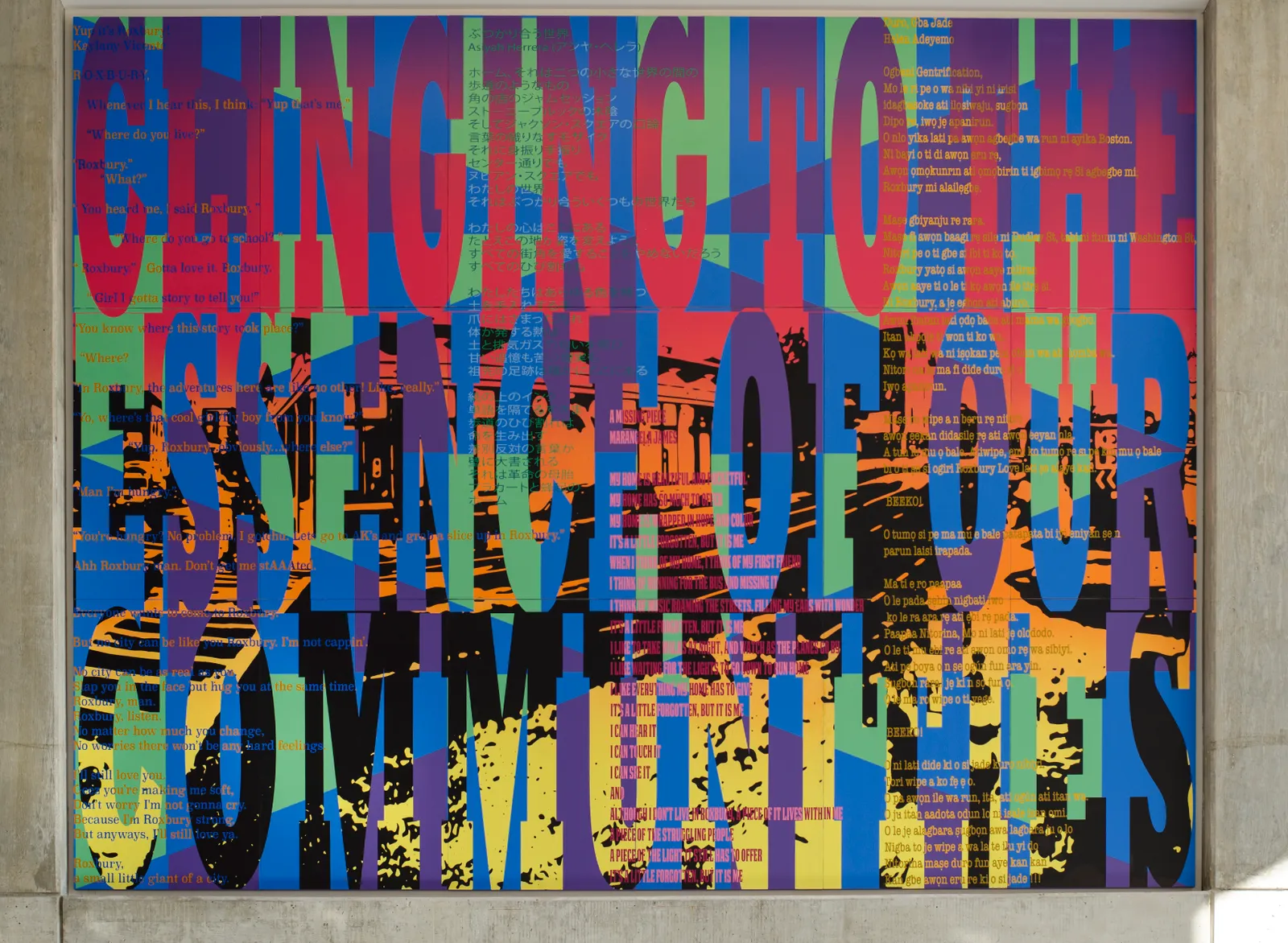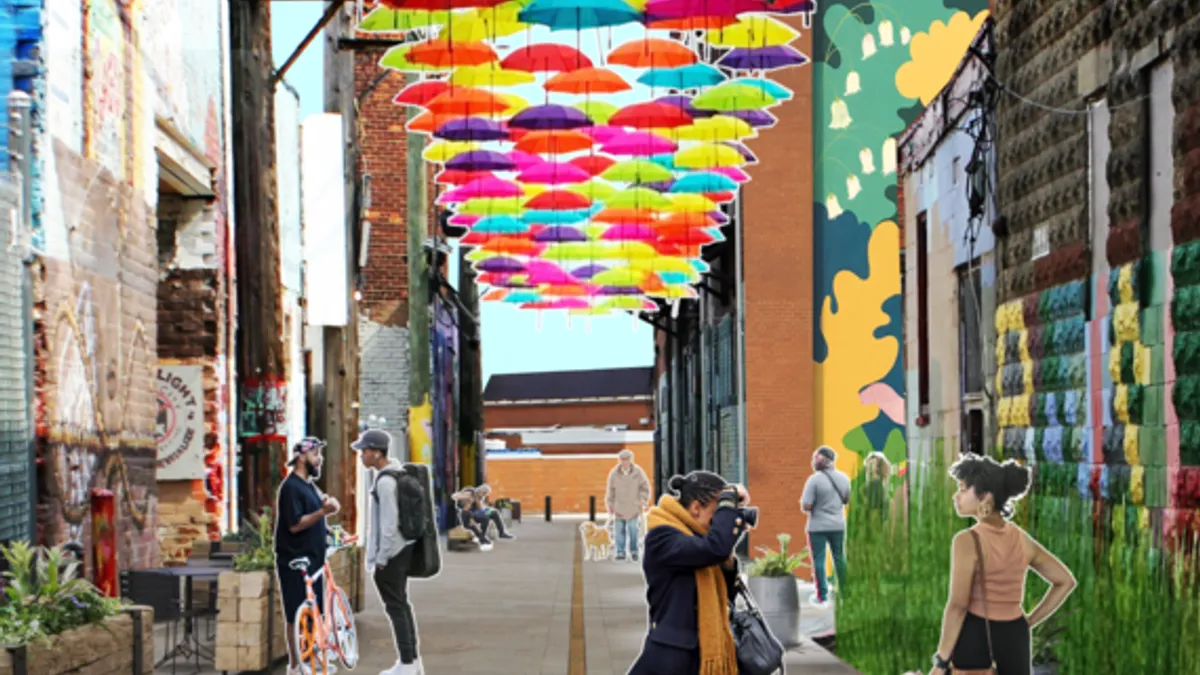In Detroit, city officials envision colorful murals covering the walls that flank an alley. Benches and planters add seating and color while a canopy of vibrant umbrellas provides shade overhead.
That rendering was among those city officials introduced in July as part of Detroit’s Arts Alleys initiative. Launched by Mayor Mike Deggan and the city’s Office of Arts, Culture and Entrepreneurship, the plan is intended to transform commercial and residential alleys in five neighborhoods throughout the city into gathering spaces in which residents can experience and exhibit art.
The initiative will leverage $3 million in American Rescue Plan Act funds along with an unspecified amount from the Ford Foundation. The goal, according to the announcement, is to “spur neighborhood development and revitalization, mitigate localized flooding through low-cost stormwater management strategies, create opportunities for the creative workforce, and highlight neighborhood creativity.”
Many other cities throughout the U.S. have launched similar arts initiatives to boost community engagement, beautify their neighborhoods and help artists.
The National League of Cities Institute, in partnership with One Nation One Project, launched an Arts & Health initiative earlier this year with nine cities of diverse sizes, with a goal of using art and culture to improve well-being and social cohesion and reduce the community impacts of COVID-19, the NLC stated in a press release. The goals vary among cities, as each set of goals is rooted in local needs and challenges, NLC said. For example, the emphasis in Rhinelander, Wisconsin, is on improving youth and adolescent mental health, while in Gainesville, Florida, the focus is on creating connectedness to improve social cohesion.
For the most part, Detroit’s Arts Alleys initiative will build on work already underway by community groups, said Rochelle Riley, the city’s director of arts and culture. For instance, residents of the Schulze neighborhood are already using an alley as a gathering space. The initiative will help elevate their work, she said.
Arts Alleys, a key element of the city’s Blight to Beauty initiative, will make “spaces better, prettier and more useful,” Riley said. “My Detroit is beautiful, and I want every Detroiter to be able to say that,” she added.
Here’s a look at two other cities’ recent public art initiatives:
Boston
In Boston, multiple arts programs, including the Transformative Public Art Program, Boston Artists in Residence and Reopen Creative Boston, support a range of arts as well as the artists that create them. These initiatives strive to both increase opportunities for the public to engage in arts programming and creative expression and to invest in artists as part of Boston’s creative economy, said Kristina McGeehan, spokesperson with the mayor’s Office of Arts and Culture.
The Transformative Public Art Program, which commissions several murals and temporary projects each year, is focusing this year on works that “usher in joy and renewal while also making space to grieve and recover,” the city said in a press release.
Through the program, a local artist and a local poet collaborated to create colorful wall murals at the Boston Public Library’s branch in Roxbury, an historically underserved area, incorporating both poetry and landscapes of the city neighborhood. The murals were installed in January.

Many of the community art programs and resources Boston has offered over the past several years stem from the city’s 2016 Boston Creates Cultural Plan, said Kara Elliott-Ortega, the city’s chief of arts and culture. That plan was developed following a community engagement process and a citywide town hall, she said. “We heard from many individual artists and creative workers who felt they needed more representation at city hall and more options for project support and professional development,” Elliott-Ortega said.
The city has since provided more than $1 million directly to artist grants, commissions, training, community events, artistic development and a city of Boston artist residency, among other projects, she said.
Many of the current programs and grants prioritize artists from historically underserved communities as well as those that experienced the most negative impact from the pandemic, Elliott-Ortega said. She noted that more than three-quarters of 2022 grantees live in one of four priority neighborhoods, and more than 86% of the Community Arts Experiences grants supported events in those neighborhoods. The latter program provides $5,000 to $10,000 grants to support free public arts activities in neighborhoods that have a lower concentration of such activities.
Chicago
E(art)H Chicago, a citywide public art initiative, “seeks to highlight the intersection between humans and nature, including issues that affect communities like climate change, environmental injustices, and natural resource use,” said Uzma Noormohamed, program director of the Illinois Science and Energy Innovation Foundation, the lead funder of the initiative.
The initiative aims to address a science communications challenge, Noormohamed explained. Environmental issues are communicated through scientific language, which can be alienating to many, she said. “Artists are essentially communicators; they can employ emotion to connect people to nature and the climate crisis in a way that inspires urgency and is also accessible.”
With its funding partners, ISEIF awarded nearly $550,000 to artists and organizations that engage communities on environmental topics through art across Chicago’s neighborhoods, she said. The grants will fund 11 projects to be showcased in June 2023.
Many of the communities have been organizing for decades for their right to breathe clean air, Noormohamed said. “We wanted to support artwork that honored their work and the healing these organizers have brought to their communities.”
One project, for example, will repurpose discarded plastic to create benches and other communal assets for Chicago’s Austin neighborhood. Workshops will help train residents to sort, clean, and transform the plastic into functional art.
Community engagement has been essential to the success of these initiatives, Noormohamed said. Starting points include listening to the artists and their needs, and then making sure the community wants the art in the neighborhoods, she said.
Similarly, outreach to let residents know about the opportunities available, while cost- and time-intensive, is also critical, Noormohamed said.
“The deep outreach was necessary from an equity perspective; many people do not hear about opportunities such as this and then don’t apply,” Noormohamed said. With the outreach, “the program received five times as many applications as expected, and the applications came from artists in different neighborhoods and with varying experience levels,” she added.
That community engagement is central to E(art)h Art Chicago, Noormohamed said. “Artists dare us to imagine a world that is different from the one we’re living in. At a time when the climate narrative is dismal, artistic vision can inspire people to act and connect with nature,” she added.
The story has been updated to include a link to the Chicago art project.



















